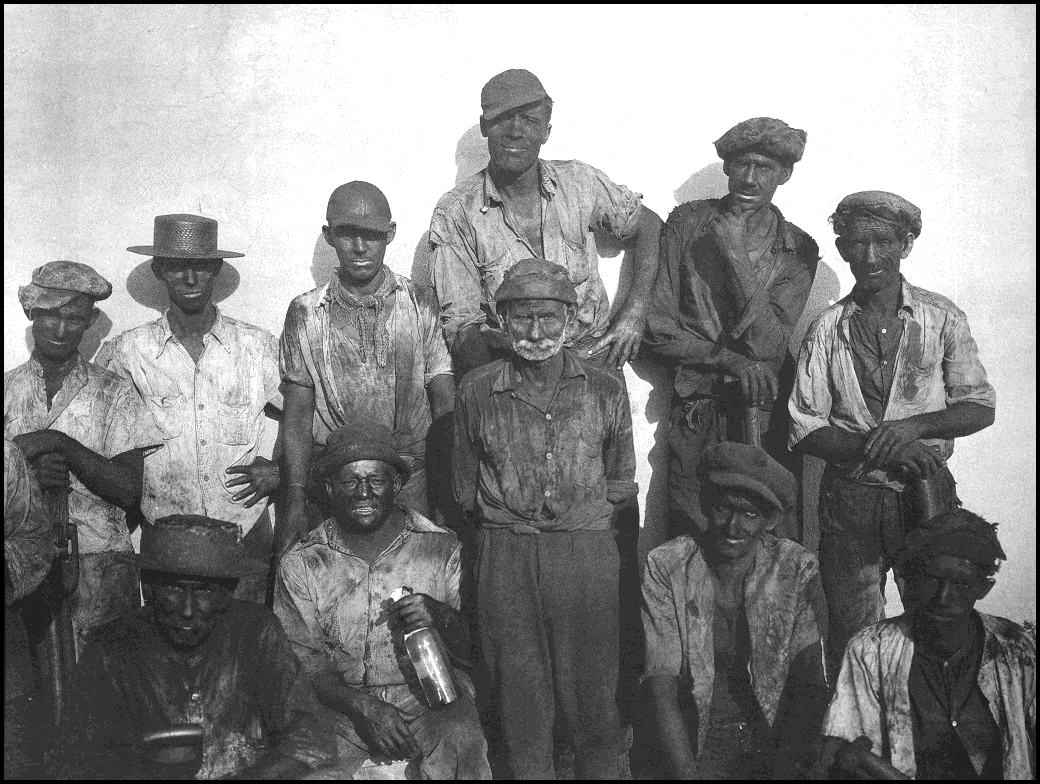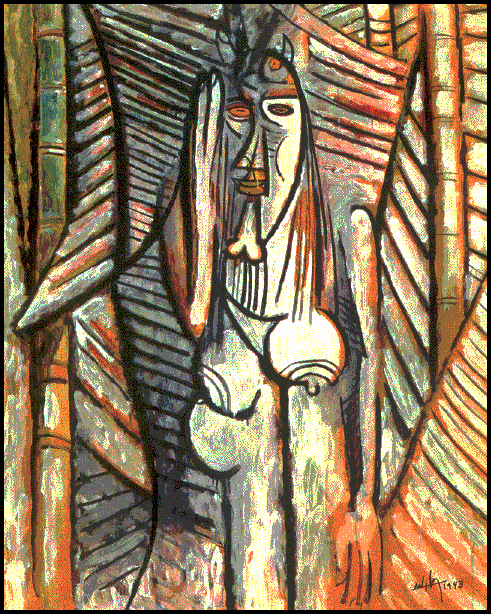
Cuba
Art and History from
1868 to Today
Moraima Clavijo Colon (Curator)
Nathalie Bondit (Director)
(The Montreal Museum
of Fine Arts/
Prestel)

In sheer volume, Cuba Art and History outdoes all the rest. Over four hundred pages, at least four hundred photographs, drawings, sketches, reproductions of paintings. The time span is a century and a half, and there are almost 150 artists represented.The word "monumental" comes to mind. And I damn near broke my arm picking this one up. But its a beaut. The artists who get the most attention include two Cubans --- Marcelo Pogolotti and Wilfredo Lam --- both of whom studied extensively in Paris, met and knew the Cubists and Surrealists and Anarchists and anti-fascists: Lam spent time in Spain during the Civil War, fighting alongside the Republicans.
The third is not a Cuban at all, but the American photographer Walker Evans: thirty of his startling black-and-white photographs from the streets of 1933 Havana are shown here. Finally, there are the works of that shady but famous artist Anonymous, represented by fifty photographs and postcards, the latter mostly of the yucky sentimental school.
The editors have arbitrarily divided Cuban artistic history into five sections, which more or less follow the political fortunes of that benighted island. The first is "Depicting Cuba --- 1868 -1927," 1868 representing Cuba's first spasm of attempted Independence from Spain, the Ten Years' War, and the successful revolt that lasted from 1895 to 1898. The photographs of the Ten years' War were commissioned by the colonial authorities for the "Album Histórico Fotográfica de la Guerra."
The second part is titled "Arte Nuevo" and "the Re-creation of Identity" (whatever that means), and parallels the ruinous regime of Gerardo Machado y Morales. "Cubanness," roughly parallels that reign of Fulgencio Batista (1938 - 1959). "Within the Revolution" would, naturally, be concurrent with Castro. "The Revolution and Me" concludes it all between 1980 - 2007.
Twenty-one critics take on thirty-four essays in cinema, fine arts, photography, and literature. I am left with the conclusion as I often am in massive books of art like this that the editors have drafted experts to comment on various aspects of art, knowing that words are just words, and the ultimate reward for the consumer are (in this case) the bleak, or gorgeous, or gaudy, or subtle, or flamboyant pictures. Ads for the Tropicana Club (vulgar) are interspliced with wonderful photographs by Raúl Corrales and Ocaño Odio of the poor sleeping on the streets of Havana.
A painting by Carlos Enriquez called "The Happy Peasant" (1938) seems to presage the "Screaming Pope" of Francis Bacon. The thirty photographs by Walker Evans include a haunting shot of eleven dockworkers, faces black from their job of loading coal at the malecón at Havana. The accompanying essay by Jeff Rosenheim, "Walker Evans and The Crime of Cuba" --- referring to a book put out by J. B. Lippencott in 1933 --- is one of the few I could make it through without passing out (or on).
It's the photographs and the pre-revolutionary paintings that are the most memorable. The famous shot of Ché Guevara by Alberto Korda appears next to an essay by Iliana Cepero Amador, "Myths and Realities: Cuban Photography of the 1960s and 1970s." It was at one of those endless speechifying days with Castro in March 1960. Korda said,
I was about eight or ten metres from the podium where Fidel was speaking, and I had a camera with a semi-telephoto lens. Suddenly I noticed Ché approaching the railing beside Jean-Paul Sartre and Simone de Beauvoir. He had been standing at the back and came forward to look at the crowd. I had him in focus. I took one shot and then another, and at that moment he turned away. It all happened in a half a minute.
After Ché was murdered in 1967, the Italian publisher Giangiacomo Feltrinelli "reproduced and printed the image on millions of posters that sold across the globe."
For many years, Korda never received a cent in royalties for this photo, considered the most frequently reproduced image in the history of photography.
Amador describes the conscious sexiness of the leaders of the revolution. The macho army fatigues, the beards, the cigars. "The informal settings and animated gestures suggestive of the world of advertising narrowed distances: the leaders were shown playing baseball, fishing and reading: activities with which all Cubans could easily identify. They were trustworthy men."
Nevertheless, Fidel's stern bearing in Korda's Commandante en Jefe or Che's world-famous Heroic Guerrilla spoke of persistent qualities in the potent placement of these figures in a frozen world, a timeless world of political commitment and eternal ideals, paradoxically well-grounded at the same time in a firm belief in the future.
It is no accident that Korda's "trajectory in the advertising and fashion industries and his veneration of Richard Avedon had shaped a career in which the celebration of beauty joined with psychological insight." Fidel had chosen Korda as his personal photographer from the beginning.

Our favorite in this treasure-trove is Wilfredo Lam. Half Chinese, half Afro-Cuban, he lived in Paris for seventeen years, "praised by Picasso and admired by Breton." But the coming of the Nazis drove him back to Cuba.He had been influenced by African art, and in Cuba he said that he wanted to invest "the spirit of the blacks, the beauty of the art of the blacks."
This way I would be like a Trojan horse from which would emerge fantastic figures capable of surprising, of troubling the exploiters dreams.
The editors have included twenty-one Lam paintings in reproduction here, and they are a kick. Boobs and asses and funny duck-feet, breasts over here, lips over there, faces hung around off to the side, tails and toes. It's a menage out there, and thank god that Lam has been rescued to charm us here.
Some other "modern" Cuban art --- Martínez Pedro, (blobby circles); Lolé Soldevilla (moonish cutouts); José Gómez Fresquet (laughing children in red; mournful woman in blue); Servando Cabrera Moreno (big dong ... I mean big); Raúl Martínez ("Todos Somos Hijos de la Patria") all leave this writer cold. Only the later photographs continue to entrance --- innocent shots of kids bathing by Manuel Piña, huge closeups of skin and lips by René Peña. And too much of the revolutionary stuff is hectoring without being artful.
The editors and the Montreal Museum deserve a big hurrah for this one. They have neatly skirted the appalling politics of Cuba, a small nation that merely wanted to be out of the shadow of Spain (at first), then the ham-fisted ministrations of the United States (second). Readers who have doubts about the latter may want to look through a recent biography of Fulgencio Batista: From Revolutionary to Strongman to learn how heavy the hand from the north came down to screw the poor and the innocent in the name of "international security."
The historian Hugh Thomas, in his massive history of Cuba, opined that both countries would have been better off if the United States had just moved in and taken over Cuba 1898. We doubt it. Castro's weighty rule is, perhaps, no better nor more just --- but at least it grew out of the hot cane fields of the Oriente, not the cold halls of Foggy Bottom. Cuba has suffered mightily from a half-century depression, mostly brought on by the embargo from the north (punish the administration / impoverish the peasant school of internationalism), but at the same time Cuba has avoided the anarchy, the trashing of culture and ecosystems that have bedeviled the likes of Puerto Rico, Hawaii, and the once Virgin Islands.
--- Carlos Amantea